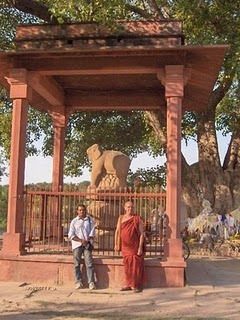SAðKASSA

Saïkassa (Sanskrit Saïkasya) was a town on the western edge of the Middle Land. Legend says the Buddha descended from the Tavtiüsa heaven at this place after spending three months teaching abhidhamma to his mother, who had been reborn there after her death. Supposedly three ladders appeared in the sky Ý a golden one on the right for the god Sakka, a silver one on the left for Brahma and a jeweled one in the middle for the Buddha. Some versions of the legend say that Brahma held an umbrella over the Buddha as he descended from heaven to earth.
This so-called miracle at Saïkassa is not mentioned in the Tipiñaka. The place itself is only referred twice and the Buddha only visited it once, passing through it while on his way to somewhere else (Vin.II,299; III,11). Apart from being incredible in itself, the Saïkassa legend contradicts that Buddha's prohibition against the public display of psychic powers or miraculous abilities (Vin.II,110-111). There is also no mention in the scriptures of the Buddha mysteriously disappearing from the scene for three months. The Saïkassa legend's association with the abhidhamma is a key to its origin and rationale.
The abhidhamma is conspicuous by its absence from the Buddha's discourses. It is not mentioned as one of the nine branches of the Buddha's teachings (navaïga, A.II,103), and the account of the First Council describes the recitation of the monastic rules (vinaya) and the discourses (suttas), but not of the abhidhamma (Vin.II,285). As the abhidhamma approach became more popular in the centuries after the Buddha's passing, and the books of the Abhidhamma Piñaka were gradually composed, pressure grew to have them considered canonical and included in the Tipiñaka. In time an explanation of the abhidhamma's origin was needed and thus the legend of the Buddha going to heaven to teach the Abhidhamma Pitaka evolved.
King Asoka raised a great stone pillar at Saïkassa, parts of which can still be seen there. There is, however, no evidence that this pillar was raised to commemorate the legend, which may not come into existence at that time. The earliest evidence of the Saïkassa legend is a sculptural depiction of it from Sanchi which dates from about the 1st century BCE.